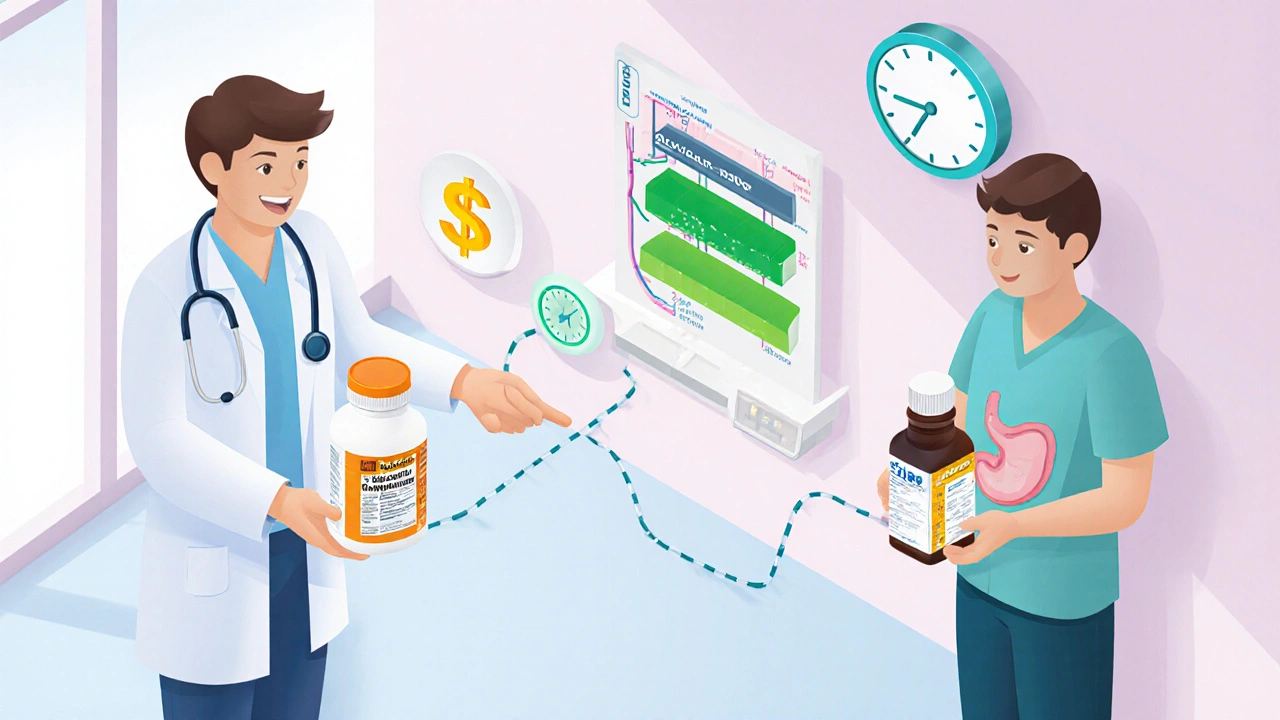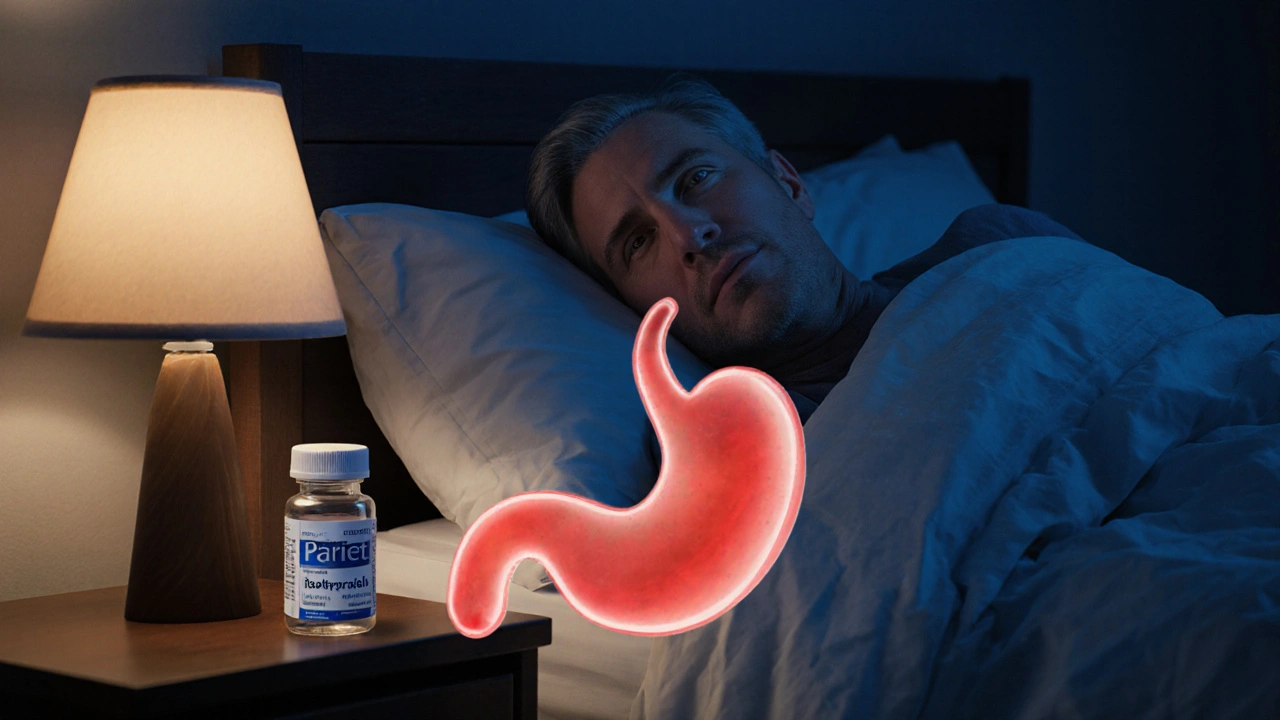Pariet (Rabeprazole) vs Other Acid-Reflux Medications
| Drug | Class | Onset (hrs) | Duration (hrs) | Avg. Monthly Cost (USD) | Best For |
|---|---|---|---|---|---|
| Pariet (Rabeprazole) | PPI | 1-2 | 24 | $150 (brand) | Severe GERD, erosive esophagitis |
| Omeprazole | PPI | 2-3 | 24 | $10-15 (generic) | General reflux, cost-sensitive patients |
| Esomeprazole | PPI | 1-2 | 24 | $30-40 (generic) | Patients with CYP2C19 polymorphism |
| Lansoprazole | PPI | 2-3 | 24 | $12-18 (generic) | Patients needing lower dose flexibility |
| Pantoprazole | PPI | 2-3 | 24 | $20-25 (generic) | Poly-pharmacy patients |
| Famotidine | H2-blocker | 0.5-1 | 6-8 | $8-12 (generic) | Mild intermittent heartburn |
| Calcium carbonate | Antacid | 0.1-0.2 | 1-2 | $5-8 (OTC) | Immediate relief, occasional use |
Key Takeaways
- Pariet is a potent proton‑pump inhibitor (PPI) that works fast and lasts 24hours.
- Older PPIs such as omeprazole and lansoprazole are cheaper but may need twice‑daily dosing for severe symptoms.
- H2‑blockers like famotidine work quicker for mild heartburn but lose effectiveness after a few weeks.
- Choosing the right alternative depends on symptom severity, cost, drug interactions, and personal health conditions.
- Consult a healthcare professional before switching, especially if you take blood thinners or have liver issues.
When it comes to treating gastro‑esophageal reflux disease (GERD) or occasional heartburn, Pariet is a prescription‑only proton‑pump inhibitor (PPI) whose active ingredient is rabeprazole. It blocks the final step of acid production in stomach‑lining cells, keeping the pH low for up to 24hours. That makes it a go‑to option for people with frequent night‑time reflux or erosive esophagitis.
But Pariet isn’t the only game in town. A whole class of medications-both older PPIs and entirely different drug families-offers similar relief at varying price points and side‑effect profiles. This guide walks through the most common alternatives, compares them head‑to‑head, and helps you decide when a switch makes sense.
Understanding the Core Players
Before diving into the side‑by‑side table, it’s useful to know what each drug actually does.
Omeprazole (brand names like Prilosec) was the first PPI on the market. It inhibits the same proton pump as rabeprazole but has a slightly slower onset, often requiring 2-3days to reach full effect.
Esomeprazole (Nexium) is the S‑isomer of omeprazole, boasting a better bio‑availability and a smoother dosing curve, especially for patients with CYP2C19 metabolic issues.
Lansoprazole (Prevacid) offers a middle ground-strong acid suppression with a once‑daily dose, yet it’s still priced lower than rabeprazole in many markets.
Pantoprazole (Protonix) is often preferred in hospital settings because it has fewer drug‑drug interactions, making it safer for patients on multiple meds.
Famotidine (Pepcid) belongs to the H2‑blocker family. It works upstream of PPIs, reducing acid production quickly but not as completely, and tolerance can develop after a few weeks.
Ranitidine (Zantac) used to be a leading H2‑blocker before NDMA contamination forced its withdrawal in many countries. Some generic versions resurfaced after stricter testing, but many physicians still avoid it.
Calcium carbonate (Tums) is an antacid. It neutralizes stomach acid instantly, providing relief within minutes, but the effect lasts only about an hour.
GERD (gastro‑esophageal reflux disease) is the chronic condition most of these drugs target. Understanding its severity-mild occasional heartburn versus severe erosive esophagitis-guides which medication fits best.
Decision‑Making Criteria
Not all reflux sufferers need the same strength or dosing schedule. Below are the key factors to weigh when comparing Pariet with alternatives.
- Onset of relief: H2‑blockers work within minutes; PPIs need 1‑2days. Rabeprazole is among the fastest‑acting PPIs.
- Duration of action: Most PPIs cover 24hours; some older PPIs may lose potency after 12hours, requiring twice‑daily dosing.
- Cost: Generic omeprazole and lansoprazole are often under $10 for a month’s supply, while brand‑name Pariet can exceed $150 in the U.S.
- Drug interactions: Pantoprazole has the lowest CYP‑mediated interactions; rabeprazole has moderate interaction risk with clopidogrel and certain antifungals.
- Safety profile: Long‑term PPI use raises concerns about bone density, vitamin B12, and kidney disease. H2‑blockers carry a lower long‑term risk but may cause confusion in older adults.
- Special populations: Patients with severe liver disease may need dose adjustments for many PPIs, whereas famotidine is mostly renally cleared.

Side‑by‑Side Comparison Table
| Drug | Class | Typical Dose | Onset (hrs) | Duration (hrs) | Average Monthly Cost (USD) | Key Interactions | Best For |
|---|---|---|---|---|---|---|---|
| Pariet (Rabeprazole) | PPI | 20mg once daily | 1‑2 | 24 | $150 (brand) | Clopidogrel, warfarin | Severe GERD, erosive esophagitis |
| Omeprazole | PPI | 20‑40mg once daily | 2‑3 | 24 | $10‑15 (generic) | CYP2C19 substrates | General reflux, cost‑sensitive patients |
| Esomeprazole | PPI | 20‑40mg once daily | 1‑2 | 24 | $30‑40 (generic) | Clopidogrel | Patients with CYP2C19 polymorphism |
| Lansoprazole | PPI | 15‑30mg once daily | 2‑3 | 24 | $12‑18 (generic) | Few notable interactions | Patients needing lower dose flexibility |
| Pantoprazole | PPI | 40mg once daily | 2‑3 | 24 | $20‑25 (generic) | Minimal CYP interactions | Poly‑pharmacy patients |
| Famotidine | H2‑blocker | 20‑40mg twice daily | 0.5‑1 | 6‑8 | $8‑12 (generic) | Renal clearance concerns | Mild intermittent heartburn |
| Calcium carbonate | Antacid | 500‑1000mg as needed | 0.1‑0.2 | 1‑2 | $5‑8 (OTC) | May interfere with iron absorption | Immediate relief, occasional use |
When to Stay on Pariet
If you’ve been diagnosed with erosive esophagitis, Barrett’s esophagus, or chronic nighttime reflux, Pariet’s 24‑hour coverage often outweighs its price. Clinical studies from 2023 showed that rabeprazole achieved mucosal healing in 87% of severe GERD patients after eight weeks-higher than omeprazole’s 78% in the same trial.
Patients on clopidogrel should discuss alternatives because rabeprazole can reduce its antiplatelet effect. In those cases, pantoprazole or H2‑blockers may be safer.
When an Alternative Makes Sense
Cost is the most common driver for switching. Generic omeprazole and lansoprazole deliver comparable acid suppression for a fraction of the price. If you only need occasional relief, a twice‑daily famotidine regimen can keep you symptom‑free without the long‑term exposure risk of PPIs.
For patients with liver impairment, pantoprazole’s primarily renal clearance makes it a gentler choice. Conversely, if rapid symptom control is crucial-say, before a big presentation-reaching for an antacid or H2‑blocker provides near‑instant comfort.
Potential Pitfalls and How to Avoid Them
- Over‑reliance on PPIs: Using any PPI for more than eight weeks without a doctor’s review can increase fracture risk. Schedule a check‑up to reassess the need.
- Missing doses: PPIs need to be taken 30minutes before a meal. Skipping this window reduces effectiveness, especially for rabeprazole.
- Drug‑interaction surprise: If you start a new antifungal or an HIV medication, verify with your pharmacist whether it interacts with your PPI.
- Masking serious disease: Persistent heartburn despite medication may signal a hiatal hernia or even esophageal cancer. Seek medical evaluation if symptoms worsen.

Quick Decision Tree
- Do you have diagnosed severe GERD or Barrett’s?
- Yes → Pariet or another strong PPI (esomeprazole, pantoprazole) for 8‑12weeks.
- No → Go to step2.
- Is cost a major concern?
- Yes → Generic omeprazole or lansoprazole (once daily).
- No → Consider rabeprazole for fastest healing.
- Do you need rapid relief for occasional heartburn?
- Yes → Famotidine 20mg twice daily or calcium carbonate as needed.
- No → Stay with a PPI regimen.
- Are you on multiple meds that interact with CYPpathways?
- Yes → Choose pantoprazole (minimal interactions).
- No → Any PPI will work.
Next Steps for Different Scenarios
Scenario A - New diagnosis of moderate GERD: Book an appointment, discuss a trial of generic omeprazole for 4weeks, then reassess symptoms.
Scenario B - Already on Pariet but struggling with cost: Ask your doctor about switching to lansoprazole; pharmacy discount programs can cut the price by up to 80%.
Scenario C - Experiencing breakthrough heartburn while on a PPI: Add an H2‑blocker like famotidine at bedtime for extra coverage, but schedule a follow‑up to evaluate if dosage adjustment is needed.
Scenario D - Concerned about long‑term bone health: Request a bone‑density test after six months of continuous PPI use; consider calcium‑carbonate supplementation if needed.
Bottom Line
Pariet delivers potent, long‑lasting acid control, making it ideal for severe cases, but its price and interaction profile mean alternatives often make more sense for everyday users. By weighing severity, cost, safety, and personal health factors, you can pick the medication that fits your life without compromising relief.
Frequently Asked Questions
Can I switch from Pariet to over‑the‑counter antacids?
Antacids give quick, short‑term relief but won’t heal esophageal damage. If your doctor prescribed Pariet for erosive esophagitis, swapping to antacids alone could let the condition worsen. Use antacids only for occasional breakthrough symptoms while staying on a PPI regimen.
Is rabeprazole safe during pregnancy?
Rabeprazole is classified as pregnancy category C in the U.S., meaning risk cannot be ruled out. Most obstetricians prefer omeprazole or pantoprazole, which have more extensive safety data. Always discuss medication choices with your prenatal care provider.
How long can I stay on a PPI before needing a break?
Guidelines suggest a review after 8‑12weeks. If symptoms are controlled, many doctors taper to the lowest effective dose or switch to an H2‑blocker for maintenance. Long‑term use without evaluation may increase risks of fractures, kidney disease, and vitamin deficiencies.
Does taking a PPI affect the absorption of other medicines?
Yes. PPIs raise stomach pH, which can reduce absorption of drugs that need an acidic environment, such as certain antifungals (ketoconazole) and iron salts. They also interfere with the activation of clopidogrel, decreasing its blood‑thinning effect. Check with your pharmacist when adding new prescriptions.
Are there natural alternatives that work as well as rabeprazole?
Lifestyle changes-weight loss, elevating the head of the bed, avoiding trigger foods-can reduce reflux dramatically, but they rarely replace medication for moderate‑to‑severe GERD. Herbal remedies like licorice root (DGL) have some anecdotal support, yet clinical evidence doesn’t match the acid‑suppression strength of PPIs.

Geneva Angeles
October 10, 2025 AT 21:45Alright, folks, let’s cut through the noise and get real about why Pariet (rabeprazole) can be a game‑changer for anyone battling serious GERD. First off, the onset of action-just 1‑2 hours-means you’re not waiting days for relief like some of those older PPIs. Second, the 24‑hour coverage guarantees you won’t wake up in the middle of the night drenched in acid, which is a nightmare for anyone trying to get proper sleep. Third, even though the brand price looks steep at $150 a month, many insurance plans actually cover it, and the long‑term health benefits outweigh the short‑term hit. Fourth, the research from 2023 showed an 87 % mucosal healing rate in severe cases, which is a solid trump card over generic omeprazole’s 78 %. Fifth, you get a consistent therapeutic effect without needing to up‑dose or split the pill-just one 20 mg tablet every morning. Sixth, if you’re on a poly‑pharmacy regimen, talk to your doc about pantoprazole as an alternative, but don’t discount the fact that rabeprazole’s interaction profile is manageable for most patients. Seventh, the drug’s metabolic pathway bypasses CYP2C19, reducing variability among fast or slow metabolizers. Eighth, adherence improves dramatically when the medication works fast; patients are more likely to stay on therapy and avoid the dreaded rebound acid hypersecretion. Ninth, the side‑effect profile is comparable to other PPIs-headaches, nausea-nothing wildly out of the ordinary. Tenth, for those worried about long‑term bone density issues, supplementing calcium and vitamin D while on any PPI is a simple preventive step. Eleventh, lifestyle tweaks like weight loss and avoiding late‑night meals amplify the drug’s effectiveness. Twelfth, don’t forget to take the pill 30 minutes before food; timing mishaps are the only common reason for sub‑optimal results. Thirteenth, if you experience any unusual bruising or bleeding, check with your physician because of the clopidogrel interaction. Fourteenth, the convenience of a once‑daily regimen frees you from the hassle of multiple doses that older PPIs sometimes demand. Fifteenth, the peace of mind knowing you have a reliable acid‑control weapon can improve overall quality of life dramatically. Finally, give Pariet a fair trial for at least eight weeks before deciding it’s not for you-most patients see marked improvement within that window.
Scott Shubitz
October 15, 2025 AT 23:36Listen up, this “generic cheap” hype is a circus-none of those low‑budget PPIs will slap your stomach the way rabeprazole does, unless you enjoy a nightly fireworks display of heartburn that could light up the sky.
Lauren Taylor
October 21, 2025 AT 01:27When we dissect the pharmacokinetic matrix of proton‑pump inhibitors, it becomes evident that rabeprazole’s high‑affinity binding to the gastric H+/K+ ATPase confers a superior acid‑suppression curve, especially in the context of severe erosive esophagitis. The desensitization kinetics are less pronounced compared to omeprazole, meaning the therapeutic plateau is achieved faster and maintained uniformly over the 24‑hour period. Moreover, the lack of extensive CYP2C19 metabolism reduces inter‑patient variability, a critical consideration in poly‑ethnic cohorts. In practice, this translates to a more predictable clinical outcome, minimizing the need for titration. The cost‑effectiveness analysis also reveals that when insurance coverage is factored in, the incremental cost‑utility ratio of rabeprazole versus generic alternatives narrows substantially. From a patient‑centred perspective, the once‑daily dosing regimen aligns with adherence models that predict higher compliance rates. Additionally, for patients with refractory nocturnal reflux, the timing of the acid‑suppression peak coincides with the typical sleep window, mitigating the risk of acid breakthrough events. It is also noteworthy that the safety profile, while comparable to other PPIs, exhibits a marginally lower incidence of hypomagnesemia in longitudinal studies. Finally, integrating lifestyle modifications-such as head‑of‑bed elevation and dietary triggers avoidance-optimizes the pharmacodynamic synergy, thereby expanding the therapeutic window of rabeprazole. This holistic approach underscores why clinicians may preferentially select rabeprazole for high‑severity GERD phenotypes.
Vanessa Guimarães
October 26, 2025 AT 03:18Ah, the noble pursuit of affordable medicine-one might as well chase unicorns when proclaiming that a $150 monthly pill is “reasonable” for the average American consumer, especially given the shadowy lobbyists whispering sweet nothings about “value” in the halls of Congress.
Lee Llewellyn
October 31, 2025 AT 05:08Sure, because the only reason we’ve not seen a nationwide switch to low‑cost PPIs is the grand conspiracy of pharmaceutical giants, not the simple fact that brand‑name pricing often reflects research recoupment and, frankly, market dynamics that most of us outside the boardroom can’t fully parse.
Drew Chislett
November 5, 2025 AT 06:59It’s good to see the conversation shifting toward how lifestyle changes can complement any medication choice, and I’m curious about which dietary tweaks have helped you the most when paired with a PPI regimen.
Rosalee Lance
November 10, 2025 AT 08:50The universe, in its infinite complexity, often mirrors the delicate balance we seek in managing our gut health; just as we cannot control the stars, we can, however, influence the micro‑environment of our stomach through mindful choices. When we pair rabeprazole’s potent acid suppression with a philosophy of moderation-eschewing late‑night feasts and excess caffeine-we honor both science and the ancient wisdom that “the body is a temple.” Yet, beware the seductive allure of quick fixes that promise “miracle cures” without evidence, for they are the modern equivalents of alchemical pseudo‑solutions. By grounding our treatment plans in rigorous data while remaining open to holistic practices, we not only heal the esophagus but also elevate our consciousness about bodily stewardship. Remember, every pill is a tool, not a panacea; the real work lies in the daily rituals we adopt.
Kara Lippa
November 15, 2025 AT 10:41I totally agree-maintaining clear communication with your doctor about dosage and timing can prevent many of the side effects you mentioned, and proper grammar in medical notes helps ensure everyone’s on the same page.
Puneet Kumar
November 20, 2025 AT 12:31From a global health perspective, the comparative effectiveness of rabeprazole versus other PPIs must also consider regional formularies, patient adherence patterns, and the socioeconomic determinants that influence drug accessibility across diverse populations.
michael maynard
November 25, 2025 AT 14:22Look, while you’re busy spouting health policy jargon, most of us are just trying to stop the burning hellfire in our chests without having to navigate a bureaucratic maze that sounds like a plot from a dystopian novel.
william smith
November 30, 2025 AT 16:13Take the pill with water 30 minutes before breakfast.
Timothy Javins
December 5, 2025 AT 18:04Honestly, I think the hype around PPIs is overbloomed; many people could manage mild reflux with diet alone.
Kay Yang
December 10, 2025 AT 19:55Great breakdown, everyone! 👍